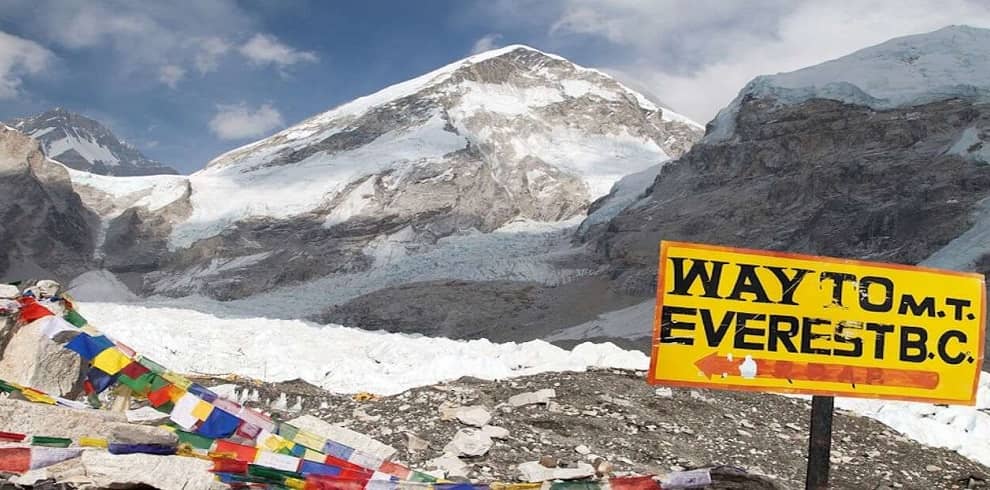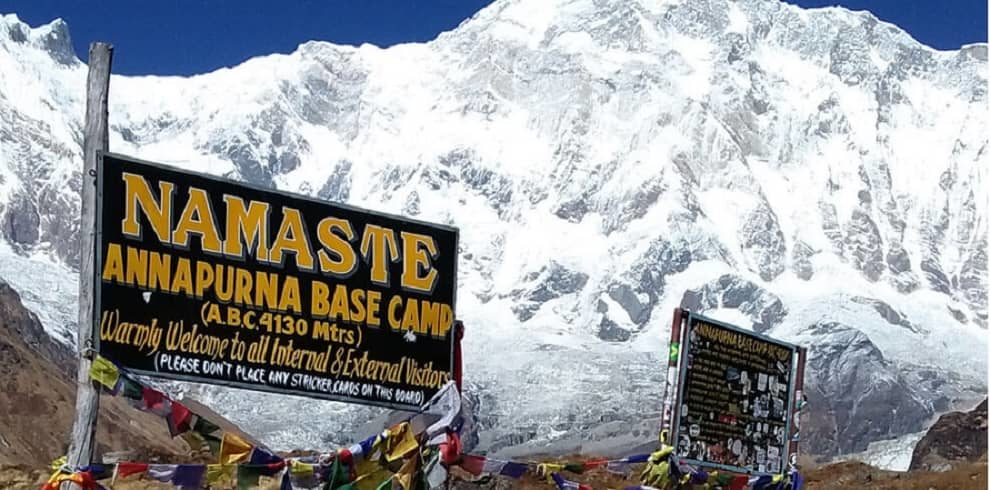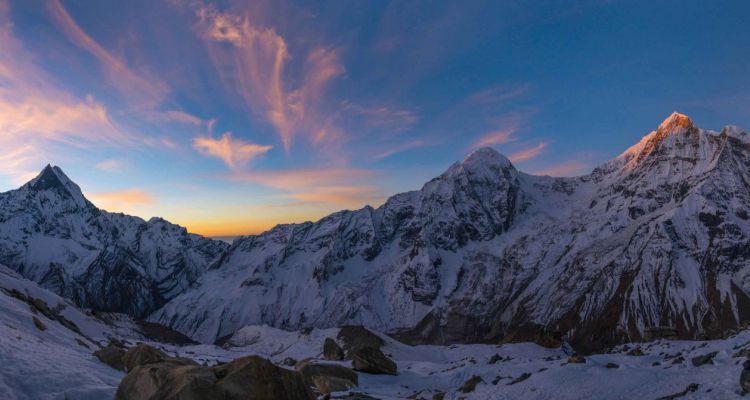Introduction To Mount Everest Base Camp Trek In Nepal
The Mount Everest Base Camp Trek is possibly the most well-known trek on the planet. At an elevation of 5,364m / 17,598ft, it brings you close to the top of the planet.
The Mount Everest Base Camp Trek takes place in the Mt. Everest region, which includes the world’s highest summit, Mt. Everest (8,849m/29,031ft).
The walk takes you through breathtaking scenery, stunning lakes, glaciers, traditional Sherpa communities, and remarkable Buddhist monasteries, giving you a glimpse into how locals adapt to these harsh environments.
The EBC journey begins with a breathtaking 40-minute flight to Lukla, then a short climb to Phakding (2,610m/ 8,562ft). The scenery you’ll be traveling through will be breathtaking and exotic.
You’ll be surrounded by massive mountains on your trial, and as you continue, you’ll reach Namche Bazaar (3,440m/11,268ft), our target for the day.
We will spend one day at Namche Bazar acclimating to the high altitudes. However, you have a variety of options for how to spend your day.
You can go to the Sherpa museum to learn about the Sherpa culture and history, hike to Syangboche Airport for spectacular views, see yak farms, or go up to the Hotel Everest View Hotel (one of the highest placed hotels in the world – 13,000ft).
You can also go to the Khumjung Monastery, which is said to be home to a yeti’s scalp.
The next day, we’ll leave Namche Bazaar and climb to Tengboche, which is home to the Tengboche Monastery (3,867m/12,687ft). The atmosphere is serene, tranquil, and spiritually uplifting.
We will wake up early the next morning after spending the night at Tengboche and continue our trip to Dingboche (4,410m / 14,470ft).
You can see Mt. Ama Dablam from the walkway, which offers breathtaking views. You will have gained a significant amount of height by the time you get to Dingboche. As a result, we’ve set aside the next day for acclimatization at Dingboche.
We’ll take a short climb to Dingboche ridge to experience panoramic views of Lhotse, Island Peak, and the backside of Ama Dablam while acclimating.
The majestic mountains that rise above the Khumbu Khola Valley may be seen to the north. We will continue hiking towards Lobuche the next day after resting and recharging at Dingboche.
As we rise via Thukla Pass to the memorial park constructed to honor those who did not make it out of this region, we will be treated to an interesting journey.
We’ll spend the night at Lobuche (4,940m / 16,210ft), which is a little further along the trail.
The eighth day of your Trek will be memorable since it will be the day you arrive at your destination (5,364m / 17,598ft). However, we begin early in the morning, departing from Lobuche and traveling along the Khumbu Glacier to Gorak Shep.
We shall leave our goods here and proceed uphill to our destination.
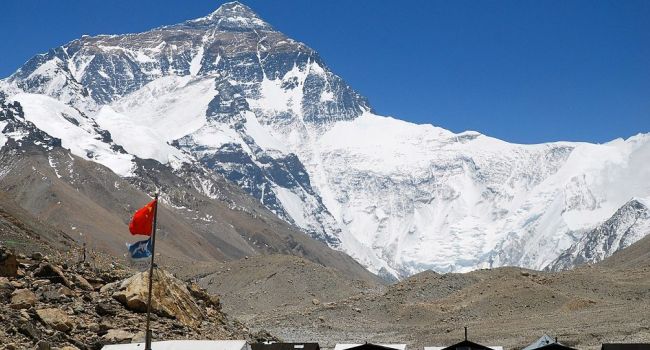
Reaching this breathtaking location is a once-in-a-lifetime opportunity. Finally, your perseverance and courage to overcome obstacles will have paid off, and you will be one of the select few who has made it to the EBC.
The Khumbu Glacier, the world’s deepest glacier at 4,900 meters, will be visible from the destination, among other sights (16,100ft). We will return to Gorak Shep, where we will spend the day, after having a fantastic experience at the Base Camp.
The next day, we’ll climb to Kala Patthar (5,555m/18,208ft) early in the morning to capture the first rays of the sun hitting Mount Everest.
We’ll return to Gorak Shep, eat breakfast, and then travel to Pheriche. We’ll spend the night at Pheriche because we’ve traveled such a long journey.
We will descend to Namche Bazaar the next day after spending the night in Pheriche. Our route will take us along the banks of the Dudh Koshi River and via the Tengboche hamlet.
You’ve almost reached the conclusion of the walk when you arrive at Namche Bazaar. At Namche Bazaar, we’ll spend the night.
We will leave Namche Bazaar on our 11th day and return to Lukla, which will be the end of your trekking and where you will spend the night. Your Tour Package has come to an end.
You’ll fly back to Kathmandu through Lukla Airport the next morning if everything goes according to plan (weather permitting).
All of our clients are encouraged to arrive in Kathmandu at least 24 hours prior to the trip departure date for a trip briefing, morale boost, and equipment inspection. Because there is a risk that flights to or from Lukla would be delayed, we recommend that our clients add two days to their journey.
Highlights Of Mount Everest Base Camp Trek In Nepal
- In Syangboche (3,780m/12,402ft), the world’s highest airport is located.
- Opportunity to learn about Sherpa culture and way of life
- Get up close and personal with the world’s highest mountain, Mt. Everest (8,848.68m/29,029 ft.).
- Mt. Lhotse (8,516m), Cho Oyu (8,201m), and Mt. Makalu are among the other high peaks visible (8,463m)
- High suspension bridges, prayer wheels, colorful flags, Mani stones (prayer stones), and prayer wheels
- A diverse array of flora and fauna
- Musk deer, multicolored pheasants, snow leopards, and Himalayan Thars are among the wildlife found in the area.
- Khumbu Glacier is the world’s highest glacier (4,900m)
- Kala Patthar offers breathtaking panoramic vistas (5,555m)
Benefits Of Mount Everest Base Camp Trek In Nepal
- Free private automobile pick-up and drop-off from the airport to the hotel and vice versa.
- At high altitudes, a pulse oximeter is used to measure blood oxygen levels. It’s a crucial signal for spotting early indicators of imminent altitude sickness and other health hazards.
- Medical Kits in Case of Emergency
- Sleeping bags and down coats can be arranged if needed, and excess luggage can be stored for free during the trekking term.
- Porters’ duffle bags
Equipment Checklist
Equipment list for Everest Base Camp Trek
This trek necessitates planning and checklists of necessary gear and equipment. It is always better to bring all of the necessary gear and equipment for the entire walk. We appreciate that you have your own wardrobe preferences, but we strongly advise that you consult with us before packing.
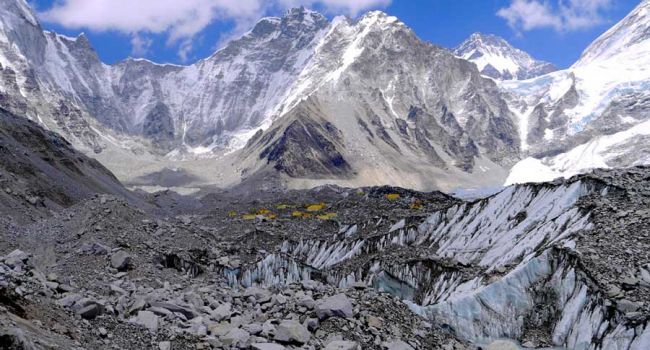
Head
- Scarf or hat for the sun
- Winter hat, insulating hat, or a hat with a wide brim
- Extra batteries for the headlight
Face
- Sunscreen
- Sunglasses that block UV rays
- Wipes for the face and body
Hands
-
Lightweight gloves
-
Heavyweight winter gloves
Body
- Shirts for hiking
- Shirt with a long sleeve made of synthetic fiber.
- Rain jacket with hood
- Jacket made of fleece
- Cotton pants that are light and airy.
- T-shirt (bring lightweight wool)
- Underwear made of polypropylene
- Jacket with down feathers (available for rent in Kathmandu)
- Sweater
- Jacket and pants that are waterproof
Footwear
- Boots for Hiking
- Socks made of thick wool (Take an extra pair of thick light socks)
Essential gear
- A daypack or a backpack (Size depends on whether you take a porter or not)
- Bottle with a heating element
- Purification of water
- Pole for hiking
- Bag for sleeping (-15 degree bag is best for high altitude trekking)
Toiletries
- a drying towel of medium size
- Toothbrush
- Toothpaste
- Deodorant/floss/toilet paper
- Biodegradable soap in a bar
- a pair of nail clippers
- Mirror, little
Personal accessories
-
Money
-
Watch
-
Cell phone
-
Camera
Extra items
- Kit for first aid
- Extra passport pictures and passport photocopies
- Pencil and notebook
- Binoculars
Guided EBC Tour Package Information
We will welcome you to Tribhuvan International Airport.
On your arrival, we will pick you up from the airport and drop you off at your hotel in a private vehicle, and vice versa on your departure. Our agent will be holding a booklet with your name on it at the Tribhuvan International Airport. As a welcoming gesture, they will either give you a Khada or Marigold garland and then drive you to your accommodation. To take use of this free service, please provide your flight information.
Tour package start
You will arrive at Kathmandu’s Tribhuvan International Airport, Nepal’s only international airport. In Kathmandu, there are many hotels to select from, and you can stay in one that best meets your needs. We can manage/recommend hotels for you if you desire. Our tour package does not include overnight accommodations prior to the expedition. Your journey will begin with a forty-minute flight from Kathmandu to Lukla.
Is EBC safe for travel?
Yes, it is correct. The EBC is a very safe place to visit. The route passes through major towns such as Lukla, Namche Bazar, Lobuche, and Gorakshep, which have a combined population of about 4,000 people. Along with our friendly personnel, you will be fully lost in the tranquility of nature.
We recognize that the terrains are difficult, thus our crew is always available to motivate and inspire you. We vaccinated all of our employees against COVID -19 and followed these procedures to ensure your safety.
- Authorized Trekking Guide Training Certificate
- Intensive Wilderness First Aid Training
- Fluency in English and another major language
- Conservation and Biodiversity Training
- Experience with rock climbing
EBC Accommodation
The EBC includes 13 nights of lodging at the best possible lodges and motels along our trekking route. All of the rooms are designed for two people to share.
We’ll spend six nights in private rooms with connected bathrooms in Lukla, Phakding (2 nights), and Namche (3 nights), and seven nights in basic rooms in Tengboche (2 nights), Lobuche, Dingbuche (2 nights), Gorakshep, and Pheriche.
Two nights at a hotel in Kathmandu are required before and after the trek but are not included in the package. Kathmandu offers a wide choice of accommodations to suit all budgets.
Hot showers and Wi-Fi are available on the route, but they come at a premium.
What about the Food
Because the hike takes place at a high altitude, your body will require a sufficient supply of carbs, proteins, and other nutrients. In many regions, you’ll find plenty of healthful and excellent cuisine, but your options are limited. In Kathmandu, there are numerous dining options.
In trek regions, we will serve 13 breakfasts, 13 lunches, and 13 dinners.
The following are some of the most popular menu items:
Oatmeal, Corn Flakes, French Toast with Jam, Butter, Cheese, and Honey Tibetan Bread or Chapati are among the thirteen-morning options. Pancakes, Muesli Breads, Fruits and Vegetables, Local Tsampa Porridge, Hashed Brown Eggs, Egg Varieties (Omelets), Muesli Breads, Fruits and Vegetables, Hot Drinks – Teas, Coffees, Hot Chocolates, etc.
Thirteen lunches, including Dhal, Bhat & Tarkari, Tibetan Bread, Various Soup Items, Tenduk, Spaghetti Noodles, Thukpa, Pasta, Sherpa Stew Steaks, Sandwiches, Momo (Dumplings) Macaroni Dishes, Vegetable Curry, Potatoes, Salad, Pizza (Tomato, Mushroom, Mixed), Snacks (Papad, Prawn), Dessert Items
Thirteen meals – Dal (lentils), Bhat (rice) & Tarkari (curry), Tibetan Bread, Various Soup Items, Sherpa Stew, Steaks, Sandwiches, Momo (dumplings), Macaroni Dishes, Tenduk, Spaghetti Noodles, Thukpa, Pasta, Vegetable Curry, Potato Items, Vegetables, Salads, Pizza (Tomato, Mushroom, Mixed), Sn
We choose the best lodges that serve food that is fresh, clean, flavorful, and nutritional. Local, Asian, and western cuisines are available on the menu, but as you climb higher, your options become more limited.
At trek locations, we strongly advise drinking plenty of liquids such as green, ginger, and lemon tea, hot lemon, garlic soup (must), and fresh veggies.
Though non-vegetarian options abound in hike locations, we do not advocate them due to cleanliness concerns. Similarly, alcoholic and caffeinated beverages, hot chocolates, and dairy products should be avoided.
All personal bills (alcoholic, hot (tea/coffee), and cold drinks) in teahouses/lodges or cafés are excluded from the package, save for standard meals (breakfast, lunch, and dinner with seasonal fruits).
What is the best time to visit EBC?
One of the most crucial elements to consider while hiking to Base Camp is the weather. You can receive a live weather prediction for Mt. Everest here, but accurate forecasting is practically impossible.
Throughout the year, tourists, professional climbers, and locals ascend to the Base Camp. Throughout the seasons, though, there are ups and downs. The greatest time to go hiking is in the spring or autumn. Normally, the sky is clear from sunset until dawn during these times. The most breathtaking vistas are provided by the bright azure skies.
One of the greatest times to visit EBC is in the spring (February to June). As the monsoon fades, ideal trekking weather appears, and most trekkers flock to EBC at this time. The temperature reaches 20 degrees during the day and 5 degrees at night. This is the greatest time to see the sights.
Flights to Lukla may be canceled frequently during the rainy season (June-September), yet hikers continue to trek at this time. We will conduct treks securely even if you want to hike during the rainy season. The trails are less congested during the off-season.
Autumn (September-November) brings cooler weather, and as the season develops, snowfall makes EBC trekking more difficult. The nights are getting cooler. During this season, Nepalese celebrate two of their most important festivals: Dashain and Tihar. Trekking is much more enjoyable during this season because of the joyful atmosphere.
From December to February, the weather becomes bitterly cold, and snow begins to fall. The weather in the Himalayas is fickle, and temperatures can shift dramatically in a matter of hours! If you want to go trekking during this season, we can arrange safe hikes for you.
The weather in the Himalayas is fickle, and temperatures can swing dramatically.
Acclimatization during EBC Trekking
Acclimatization is critical on high-altitude hikes like the EBC. If you go higher than 8000 feet, you’re more likely to get altitude sickness (2438.4m). Gains of up to 5,000 meters necessitate careful consideration.
At Namche and Dingboche, we’ve set aside two days for acclimatization. The trek’s highest peak is Kalapatthar (5,555m).
Altitude sickness is a common concern on high mountain journeys, but it is treatable and requires quick treatment. However, ignoring altitude sickness symptoms might lead to serious consequences.
At an elevation of 3,500 meters, mountain sickness is common. Our trekking leaders and guides are well-versed in altitude sickness prevention and utilize oximeters to monitor your oxygen levels.
Our routes are designed to prevent altitude sickness by allowing time for acclimatization and a gentle ascent. We also recommend that you drink plenty of water as a precaution. However, you do not need to be concerned about altitude sickness because our experts will monitor your health and advise you on how to avoid it. In the event of a severe illness, the only appropriate treatment is to descend as soon as possible.
Because some people are more vulnerable than others, your group leader will decide whether or not to call a halt to your ascent based on the overall state of each team member.
The EBC Trek | Group Trek | Private Trek
We organize both group and private treks. Group discounts are available dependent on the size of your group. The larger your group, the greater the savings. Please see our price list for further information. Simply click the – we offer group discounts – link on the right.
Having said that, we can accommodate groups of any size and even add an assistant guide for groups of 12 or more.
A typical day on the Mount Everest Trek
Every day will be different, with activities such as enjoying the journey and scenery, shooting photos, and touring the surrounding villages. As you trek, qualified expert Sherpas will provide you with information and historical details about the locations.
The majority of your luggage will be carried by our porters, but you may need to bring a small normal bag for your valuables.
After breakfast, we head off on the day’s walk between 7 and 8 a.m., depending on the length and character of the hike. After three to four hours of hiking, we’ll stop for lunch and an hour of recuperation before continuing our journey.
The afternoon stroll is usually shorter, lasting between two and three hours. You can enjoy the refreshments after you get at your overnight lodge/tea house/tent, and then you are free to explore the area.
Dinner is served between 6 and 7 p.m. After supper, you have some free time to engage in casual chat. The excursion leader/guide will give you an overview of the next day’s activities. After the briefing, you can play monopoly, play cards, or watch mountaineering films on board. Before going to bed, the majority of our guests study the Nepali language or read novels.
How to Communicate During the Trek?
For a nominal fee, you can use the internet at the lodges, but after you reach high elevations, you’ll have to communicate via phone.
Our office will connect with all of our valued clients by Signal, WhatsApp, phone, Messenger, and other means at least once a day to ensure that they are fine, safe, and comfortable.
You might get some signals along the route, depending on the network you’re using, but they’re not particularly strong at high altitudes. In Kathmandu, though, you may easily obtain a local sim card.
In most cases, you will be able to connect to the internet at all of the lodges/hotels where you will be staying.
Wi-Fi is usually available during the walk-in lodges/lodges for an additional fee.
Extra personal expenses on trekking
In Kathmandu, the clients are responsible for their own meals and lodging. You may book them conveniently online, or we can do it for you if you want.
Similarly, you must pay for visa processing, travel insurance, beverages, trip snacks, hot and cold drinks, souvenirs, and tips to trekking crew members, among other things. Bringing cash (Dollars) and changing it to Rupees is recommended. In the Nepali market, only Rupees are accepted.
Trek Costs
Treks typically last 10-16 days and cost between $1200 and $1600, including domestic flights, trekking permits, food (breakfast, lunch, and dinner), a professional trek leader, porter, hotels, and a certificate of completion.
Group discounts are available. The cost of the expedition is largely determined by whether you are traveling alone or in a company. Group travel is less expensive, but private hikes offer greater flexibility.
Electricity, battery recharge, water on trekking
In all lodges, electricity for camera and phone recharge is available at an additional expense. During the trip, you can either buy pre-packaged mineral water or bring boiled water with you. You will also receive a water-purifying pill.
We advise against drinking water from rivers or taps because the water may be contaminated.
Trek travel insurance
This Mount Everest Base Camp Trekking requires travel insurance. Before beginning the hike, all trekkers must produce a copy of their comprehensive travel insurance policy certificate to us. Medical and emergency repatriation must be covered, as well as helicopter rescue and evacuation costs at high altitudes (up to 6000m).
Based on the experiences of our former clients, we may recommend insurance firms to you. We do not, however, sell insurance coverage. Within a week of booking the trek, we ask that all trek participants provide us with their comprehensive insurance information. In an emergency, we’ll prepare a speedy, successful rescue using your insurance policy and other documentation you supplied us.
Before you acquire travel insurance, call your provider and double-check that it covers helicopter rescue and evacuation up to 6000 meters. Do not rely solely on the material of the insurance company’s website.
How to get a visa for Nepal?
Except for Indian nationals, all foreigners must have a valid visa to enter Nepal. At Tribhuvan International Airport and Nepal’s borders with India and Tibet, you can obtain an on-arrival visa. Visit www.immigration.gov.np. for additional details.
You’ll need a passport that’s valid for at least six months, a passport-size photo, and visa fees to apply for a visa. A 30-day visa costs $50 at the moment (to be paid in cash).
A free visa will be given to children under the age of ten. It is strongly recommended that you examine the current regulations. Visa regulations are subject to change at any time. Citizens of China and members of the South Asian Association for Regional Cooperation (SAARC) (Bangladesh, Bhutan, India, Maldives, Pakistan, and Sri Lanka) are exempt from visa fees.
Certain countries’ citizens may be denied a visa upon arrival. On-arrival visas are not available for citizens of Nigeria, Ghana, Zimbabwe, Swaziland, Cameroon, Somalia, Liberia, Ethiopia, Iraq, Palestine, and Afghanistan. If you are a citizen of one of these countries, please contact the Nepalese Embassy in your country.
Before we embark on our journey, we’ll double-check everything (luggage, equipment, etc.) during our briefing.
Currency Exchange in Nepal | USD to NPR
Nepali Rupees (NPR/Rs) are the local currency.
(1 USD = ~ Rs.124 NPR).
You can exchange major foreign currencies through local banks and legitimate money exchanges in Kathmandu and all over Thamel. Legitimate money exchanges display their ongoing exchange rates visibly to the public.
Please note – only 100 INR (Indian Rupees) and 2000 INR notes are legal in Nepal.
Despite having the security advantage of traveler’s cheques, we prefer cash exchange. It helps avoid lengthy processes and high bank commissions.
You can withdraw cash (in Rupees)from ATMs all over Kathmandu and Thamel itself. Many of these ATMs are open around the clock. The maximum withdrawal amount is 35,000 Rupees for a 500 Rupees processing fee for foreign cards.
If you use the money exchange facilities at banks and financial institutions, they impose a service charge fee of about 4% or more.
During the trek, there are no banks and money exchange services so you should exchange your money in Kathmandu, depending on how much personal expense you require. Only Nepali Rupee is accepted in trekking regions.
Most established banks in Asia will only accept foreign currency notes that are not old, torn, or faded. Please ensure that you have new, clean notes.
How much luggage can I take during the Trek?
Your luggage must not exceed 9 kilograms per trekker. One porter will be allocated to each of the two trekkers, and the total weight of their luggage should not exceed 18 kg. Our porters are never overworked.
You may, however, need to bring your own knapsack or backpack (with valuables or anything important). Carry only what you need. Excess baggage can be safely stored at your hotel or at our store for no charge.
Before we begin the journey, we will double-check everything (luggage, equipment, etc.) during our briefing.
Trek Safely
All of our clients’ safety, security, and happiness are guaranteed by us. We place the highest priority on your safety. For each trip, we will bring all of the essential gear, equipment, and first-aid kits. Our guides and leaders have completed thorough first-aid training.
If a trekker becomes ill as a result of the altitude, we will analyze the situation and keep everyone safe. In the event of an emergency, the rescue chopper will be on standby to transport you back to the lower elevation. Every team member will be together for safety during the walk, and there will be no danger of being lost in hazardous terrains.
Keeping Everest Region clean
Our philosophy is to photograph the voyage while leaving only footsteps. We believe in sustainable tourism and exclusively offer eco-friendly excursions.
We collaborate with the Kathmandu Environmental Education Project (KEEP) to plan eco-friendly itineraries that satisfy the needs of both tourists and local populations in the trekking areas.
Our Crew
Our knowledgeable guide/Sherpa will accompany us on the trek to ensure your safety and comfort. Your stuff will be carried by porters.
Our members are locals from high Himalayan remote places, and they have exceptional physical endurance at high altitudes.
We value all of our employees, so we pay them well and take care of their insurance, clothing, food, and lodging throughout the trip. When our guides and porters become unwell or injured, they receive medical attention.
Only happy people can make others happy, thus we always make sure that our team members are happy. Members of our trek/expedition team have the following qualifications:
- Authorized Trekking Guide Training Certificate
- Intensive Wilderness First Aid Training
- Fluency in English and another major language
- Conservation and Biodiversity Training
- Experience with rock climbing
Tipping during Mount Everest Trek
Tipping is optional and should be dependent on the quality of service received. A tip is an accepted and respected technique in Nepali society to express gratitude (Dhanyabad) for good service.
On the last day of the walk, the majority of our guests offer advice. The amount you tip is totally up to you, and it may be more or less based on your impression of service quality, the length of your trip, your budget, and your appreciation for their efforts.
100% Guaranteed EBC Trek Booking
We are a government-approved and bonded trek and tour company in Nepal. We are also members of the Nepal Mountaineering Association (NMA) and the Trekking Agency Association of Nepal (TAAN) (NMA). As a result, you may book your trek/expedition with complete trust.
As a deposit, we require 10% of the total trip cost. Within a week of booking, please send your documentation, including a copy of your passport, passport-size pictures, travel insurance policy, and arrival and departure flight information.
You can make a 10% deposit via bank transfer, western union, or online payment on our website, and the full balance when you arrive in Nepal. Cash, bank transfer, and credit cards are all acceptable methods of payment. In addition, you will receive payment choices in your email.
Last-minute Everest Trek booking in Nepal
Even though it is always a good idea to plan ahead for your excursions. However, for those who are unable to do so, we provide a special last-minute booking option. To take advantage of this benefit, you must pay the entire trip cost 24 hours before the trek’s departure.
Even while we do our best to plan treks at any time, there is a small potential of a trek delay due to events beyond our control, such as the inability to obtain air tickets or unfavorable weather.
Can I extend my trip?
If you wish to stay in Nepal for a few days after the trip, we can arrange enjoyable activities for you, such as exploring areas in and around Kathmandu, Chitwan jungle safari, paragliding, rafting, canoeing, and so on.
Feedback
We offer a farewell meal at the end of the trek, and we will also award you with a trek completion certificate after dinner (hard copy). It’s also a great opportunity to tell us about your experience and provide us feedback.
You may also visit Makalu Base Camp Trek-Cost, Distance, Itinerary, In Nepal – 22 Days
Overview Of Mount Everest Base Camp Trek
- The Mount Everest Base Camp trek is ideal for an adrenaline-pumping trek in the Everest region. From Kalapatthar, you can see Mount Everest and the other Himalayan peaks.
- The Mount Everest Base Camp Trek is a once-in-a-lifetime trip for those whose ambitions soar above the heavens. You’ll be miles away from traffic and contemporary conveniences, immersed in natural splendor.
- Also, push yourself to the limits of your personal endurance. Mount Everest Base Camp Trek has known for its beautiful mountain peaks as well as the residents’ loyalty and hospitality (the Sherpas).
